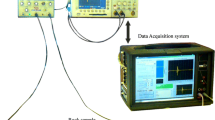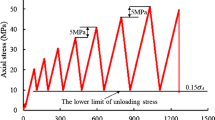Abstract
This study aims to set up a non-destructive method to control the quality of aggregates using ultrasonic wave acquisition and processing. Two applications are presented proving the applicability of the proposed methodology. The first is the characterization and classification of four limestone rocks from cement quarries in the northern part of Tunisia selected from different geological ages (Lower Jurassic, Upper Cretaceous, and Lower Eocene). The second application deals with assessing rock crushing-induced microcracking evolution in quarried rock from the first initial source rock mass to the final aggregate. Five stages were considered: before the blast (bench front), after the blast round (muck pile), after the primary crusher, after the secondary crusher, and after the tertiary crusher. A physico-chemical and ultrasonic characterization was performed on aggregates and core samples in order to identify their characteristics namely the crack porosity and P-wave velocity. A cluster statistical analysis was then adopted to classify the investigated samples into several groups where crack porosity is the most relevant factor in classifying their quality. In addition to measuring ultrasonic parameters such as the spatial attenuation and P-wave velocity, the ultrasonic study looks at the spectrum of the received signal (non-stationary and nonlinear signal) by measuring the instantaneous energy density with the Hilbert–Huang transform. Beyond the fact that the high negative correlation between the P-wave velocity and the instantaneous energy was identified, the methodology developed allowed to prove that the latter is a relevant factor for the classification of limestone rocks.

















Similar content being viewed by others
References
Armaghani D, Mohamad ET, Momeni E, Monjezi M, Narayanasamy MS (2016) Prediction of the strength and elasticity modulus of granite through an expert artificial neural network. Arab J Geosci 9(1):1–16
Battista BM, Knapp CC, Goebel VM (2007) Application of the empirical mode decomposition and Hilbert–Huang transform to seismic reflection data. Geophysics 72(2):H29–H37
Yu C, Ji S, Li Q (2016) Effects of porosity on seismic velocities, elastic moduli and Poisson’s ratios of solid materials and rocks. J Rock Mech Geotechn Eng 8(1):35–49
Chen X, Xu Z (2017) The ultrasonic P-wave velocity-stress relationship of rocks and its application. Bull Eng Geol Environ 76:661–669
Ercikdi B, Karaman K, Cihangir F, Yılmaz T, Aliyazıcıoğlu Ş, Kesimal A (2016) Core size effect on the dry and saturated ultrasonic pulse velocity of limestone samples. Ultrasonics 72:143–149
Galena E, Carretero MI, Mayoral E (1999) A methodology for locating the original quarries used for constructing historical buildings: application to Malaga Cathedral, Spain. Eng Geol 54:287–298
Gercek H (2007) Poisson’s ratio values for rocks. Int J Rock Mech Min Sci 44:1–13
Goueygou M, Lafhaj Z, Soltani F (2009) Assessment of porosity of mortar using ultrasonic Rayleigh waves. NDT E Int 42(5):353–360
Hewlett PC, Sims I, Brown B (2003) Lea’s chemistry of cement and concrete, 4th edn. Elsevier, pp 907–1015
Hamdi E, Audigier M, Du Mouza J, Fjader K (2003) Blast induced micro cracks assessment in muck pile blocks: P-wave velocity and porosity measurements. In: European Federation of Explosive Engineers. Proceedings of the 2nd world conference on explosives and blasting technique, Prague Czech Republic, pp 389–399
Hamdi E Bouden, Romdhane N, Mouza J (2008) Fragmentation energy in rock blasting. Geotech Geol Eng 26:133–146
Hamdi E Bouden, Romdhane N (2011) A tensile damage model for rocks: application to blast-induced damage assessment. Comput Geotech 38:133–141
Hamdi E, Lafhaj Z (2013) Microcracking based rock classification using ultrasonic and porosity parameters and multivariate analysis methods. Eng Geol 167(2013):27–36
Huang NE, Shen Z, Long SR, Wu MC, Shih H-H, Zheng Q, Yen N-C, Tung C-C, Liu HH (1998) The empirical mode decomposition and the Hilbert spectrum for nonlinear and non-stationary time series analysis. Proc R Soc Lond A 115:903–995
Huang NE, Shen Z, Long SR (1999) A new view of nonlinear water waves: The Hilbert spectrum. Annu Rev Fluid Mech 31:417–457
Kahraman S (2007) The correlations between the saturated and dry P-wave velocity of rocks. Ultrasonics 46:341–348
Karaman K, Kaya A, Kesimal A (2015) Effect of the specimen length on ultrasonic P-wave velocity in some volcanic rocks and limestones. J Afr Earth Sci 112(2015):142–149
Kurtuluş C, Sertçelik F, Sertçelik I (2016) Correlating physico-mechanical properties of intact rocks with P-wave velocity. Acta Geod et Geophys 51:571–582
Lafhaj Z, Goueygou M, Djerbi A, Kaczmarek M (2006) Correlation between porosity, permeability and ultrasonic parameters of mortar with variable water/cement ratio and water content. Cem Concr Res 36(4):625–633
Lafhaj Z, Richard G, Kaczmarek M, Skoczylas F (2007) Experimental determination of intrinsic permeability of limestone and concrete: comparison between in situ and laboratory results. Build Environ 42(8):3042–3050
Lin S, Yang JN, Zhou L (2005) Damage identification of a benchmark building for structural health monitoring. Smart Mater Struct 14:162–169
Martinez-Martinez J, Benavente D, Garcia Del Cura MA (2011) Spatial attenuation: the most sensitive ultrasonic parameter for detecting petrographic features and decay processes in carbonate rocks. Eng Geol 119:84–95
Martinez-Martinez J, Benavente D Garcia, Del Cura MA (2012) Comparison of the static and dynamic elastic modulus in carbonate rocks. Bull Eng Geol Environ 71:263–268
Martinez-Martinez J, Benavent D, Garcia Del Cura MA (2006) Application of ultrasonics to brecciated dolostones for assessing their mechanical properties. Geol Soc Lond IAEG, p 243
Martinez-Martinez J, Benavent D, Garcia Del Cura MA (2007) Petrographic quantification of brecciated rocks by image analysis. Application to the interpretation of elastic wave velocities. Eng Geol 90:41–54
NF P 94-410-3: Roches - Essais pour déterminer les propriétés physiques des roches - Partie 3 : détermination de la porosité. AFNOR, 3 May 2001
Paultre P (2011) Structures en béton armé: Analyse et dimensionnement. Presses internationales Polytechnique
P 18-554: Granulats - Mesures des masses volumiques, de la porosité, du coefficient d’absorption et de la teneur en eau des gravillons et cailloux. AFNOR, décembre 1990
Reyschle T, Darot M, Gueguen Y (1989) Mechanical and transport properties of crustal rocks: from single cracks to crack statistics. Phys Earth Planet Inter 55:353–360
Snoussi G, Hamdi E, Lafhaj Z (2013) Multivariate analysis methods based methodology for rock microcracking characterization. Geotech Geol Eng 32(4):973–986
Tang J-P, Chiou D-J, Chen C-W, Chiang W-L, Hsu W-K, Chen C-Y, Liu T-Y (2009) A case study of damagedetection in benchmark buildings using a Hilbert-Huang transform-based method. J Vib Control 1–14
Tourenq C, Fourmaintraux D, Denis A (1971) Propagation des ondes et discontinuités des roches. Symp. Int. Society of Rock Mechanics, Nancy, France
Ündül Ö (2016) Assessment of mineralogical and petrographic factors affecting petro-physical properties, strength and cracking processes of volcanic rocks. Eng Geol 2016(210):10–22
Vasconcelos G, Lourenco OB, Alves CAS, Vasconcelos J (2008) Ultrasonic evaluation of the physical and mechanical properties of granites. Ultrasonics 48:453–466
Wu K, Chen B, Yao W, Zhang D (2001) Effect of coarse aggregate type on mechanical properties of high-performance concrete. Cem Concr Res 31(10):1421–1425
Wen L, Luo Z, Yang S, Qin Y, Wang W (2019) Velocity on dolomitic limestone using a statistical method. Geotech Geol Eng 37(2):1079–1094
Yagiz S (2001) P-wave velocity test for assessment of geotechnical properties of some rock materials. Bull Mater Sci 34(4):947–953
Funding
There is no funding for this study.
Author information
Authors and Affiliations
Corresponding author
Ethics declarations
Conflict of interest
The authors declare that they have no conflict of interest.
Rights and permissions
About this article
Cite this article
Ezzeiri, S., Hamdi, E. Ultrasonic rock microcracking characterization and classification using Hilbert–Huang transform. Innov. Infrastruct. Solut. 5, 100 (2020). https://doi.org/10.1007/s41062-020-00347-2
Received:
Accepted:
Published:
DOI: https://doi.org/10.1007/s41062-020-00347-2




